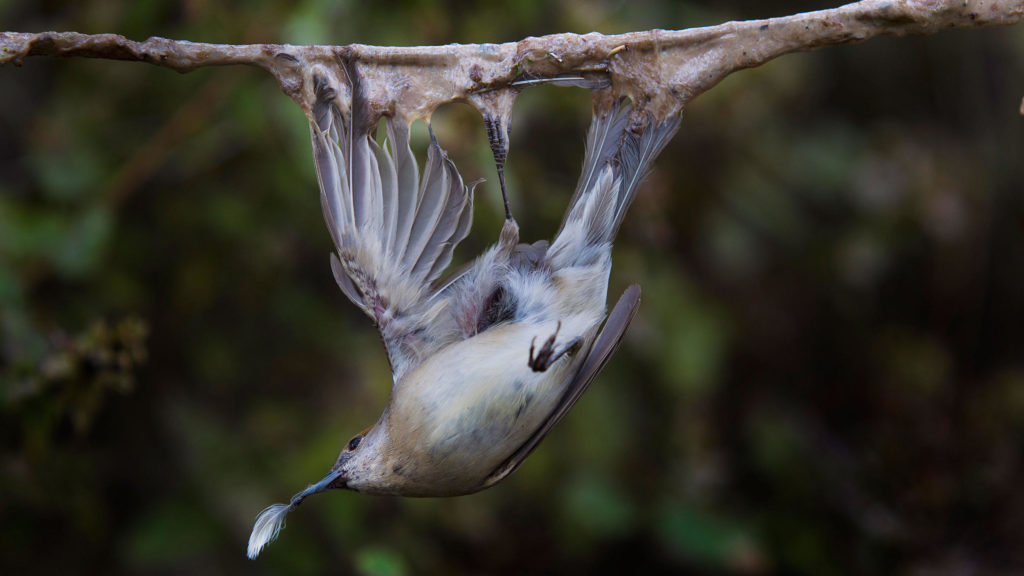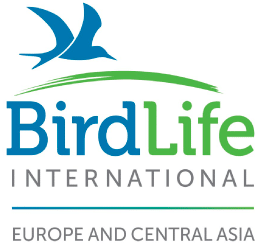Bird Trapping
There are a wide variety of techniques used to trap wild birds. Some are lethal, while others allow birds to be captured alive. These can be divided into two main types: traps involving nets and traps involving snares, glue or other triggers.

Trapped Blackcap ©Birdlife Europe
Here are some of the traps commonly use to illegally capture wild birds:
- Lime-sticks or Glue sticks
- Snares or bow trap
- Deadfall (stone) trap
- Snap traps
- Bal-chatri traps
- Mist-nets or trammel nets
- Clap net
- Munsaab trap
- Eb nets
- Toraha nets
- Esh traps
- Shirak traps for falcons,
- Haleeg nets
- Elfa traps
- Nets and thread
- Anaesthesia and tranquilizers
- Pepper
- Catapults
Tape-lures (also known as electronic callers or calling devices) are often combined with bird trapping to increase the number of birds caught. A recording of a bird song, either of a specific species or a mixture of several species, is played through a speaker on a loop. Tape-luring is often used in studies of bird migration, and the technique can strongly increase the total number of birds captured. Not all species react strongly to tape-luring, but some, like the Eurasian Blackcap (Sylvia atricapilla) are known to be attracted by it.
Lime-sticks or glue traps are particularly barbaric. Lime-sticks are twigs, about 50-70 cm long, which are covered in a ‘glue’ traditionally made by boiling up the fruit of the Syrian plum-tree or mistletoe. These sticks are placed in bushes to provide inviting perches for birds. If a bird lands on a lime-stick, it is an almost certain death sentence. The more they struggle to get away, the more their feathers, legs and beaks become coated in this sticky glue. This is a slow, lingering death. Many die of dehydration, shock or, ultimately, at the hands of the trapper who cuts their throats or snaps their necks. This practice is widely used in Cyprus and France.
Mist nets or trammel nets is a largely illegal practice in most countries. In Egypt, coastal trammel nets are the most widespread form of trapping documented along the coast. Stretching over several metres high and largely invisible, these nets catch migratory birds indiscriminately.
In a particular region of France, a practice of using baited snares, known as “tenderie” persists. This consists of capturing blackbirds and thrushes using a snare made with horsehair that is supported by a branch on which a cluster of rowanberries acts as bait. The bird passes its neck through the “snare” to reach the berries, when it tries to take flight, the bird dies of strangulation. Pepper, anaesthesia and tranquillizers are also used to suffocate birds when they roost (especially parrots in Cameroon).
What drives bird trapping?
Wild birds may be captured as a regional, traditional delicacy; for keeping as a caged bird; or for the illegal pet trade. The caged bird trade is a huge industry across Europe, Africa and the Middle East, and wild songbirds are commonly sold in outdoor markets and pet shops to the unsuspecting public. Trapped quarry bird species are also used as live decoys for hunting or pest control in certain countries. In some cases, the birds are caught and kept in the dark for months, so that when they’re taken out into daylight; they sing their hearts out and attract other birds.
What does the law say?
There are no restrictions or control on purchasing the materials of trapping nets and other tools.
In the European Union, in accordance with the 1979 Birds Directive, Member States must have specific laws and regulations governing the hunting and trapping of wild species. Thus, the trapping and consumption of songbirds is mostly illegal across the European Union, but it still occurs illegally in some Member States such as France and Italy. Trapping of certain species (song thrush, golden plover) is also still allowed in Malta in autumn-winter periods, but trapping sites need to be registered. Moreover, blinding or otherwise mutilating decoy birds is completely illegal throughout the EU.
What can you do?
Get in touch with your local BirdLife partner and see if there is a volunteer watchdog group you can join to monitor bird crime during key migratory periods.
BirdLife partners regularly host training events and bird-protection camps to ensure the safe passage of migratory birds in their autumn and spring journeys.
Please report all suspected bird crime to the police and to your local BirdLife partner.
